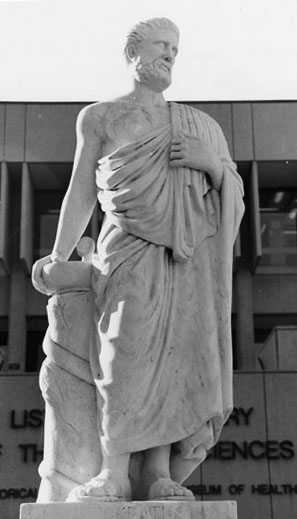Hippocrates: Father of Medicine: Difference between revisions
(Created page with "The statue of "'''Hippocrates: Father of Medicine'''" is a 14-foot-tall, 5,000-pound marble statue commissioned by Sam and Agatha Nakos as a gift from their ...") |
No edit summary |
||
| Line 1: | Line 1: | ||
The statue of "'''Hippocrates: Father of Medicine'''" is a | [[File:Hippocrates sculpture 1993.jpg|right|thumb|Hippocrates statue in 1993]] | ||
The statue of "'''Hippocrates: Father of Medicine'''" is a 8 foot, 5 inch-tall, 5,000-pound marble statue commissioned by [[Sam Nakos|Sam]] and [[Agatha Nakos]] as a gift from their [[Nakos Foundation]] to the [[UAB Medical Center|University of Alabama Medical Center]] in [[1970]]. | |||
The sculpture was | The sculpture was made by Greek artist Kostos<!--or Kostos or Kostas or Kotas or Kistas--> Nikolaou Georgakas, who depicted Hippocrates in various sizes. Six such statues, some smaller, are located at American medical schools. Hippocrates, the ethicist and legendary "father of medicine," composed the "Hippocratic oath," versions of which are still sworn by physicians. | ||
The | The work was carved from a block of Pentelic marble, the same stone used in the construction of the Akropolis in Athens. The bearded figure stands full-length, wearing sandals with a toga draped over his left shoulder. His right hand grasps the top of a stump, around which a snake had wound itself. The marble base of the sculpture is inscribed "IΠΠOKPATHΣ 490-386 B.C." The other inscriptions identify the artist, date, and donors. Additional plaques on the granite plinth below the sculpture reproduce the Hippocratic oath in Greek and English. | ||
In [[1996]] the sculpture was moved into the ground-floor lobby of the newly expanded [[Lister Hill Library]] building. | The statue was originally sited on the place between [[Lister Hill Library|Medical Center Library]] and the [[Volker Hall|Basic Science Building]]. It was originally accompanied by a "rooted cutting" from the supposed original "Tree of Hippocrates", an Oriental plane tree (''Platanus orientalis'') on the South Aegean island of Kos, under an ancestor of which the ancient Greek scholar is said to have instructed students of the Asklepion. The tree is not visible in a [[1974]] [http://www.uab.edu/archives/images/iom/0804-OPTOMETRY_LG.jpg photograph] of construction of the [[Henry B. Peters Building|School of Optometry building]]. (Another cutting from the same tree was planted in [[Walker County]] in [[1981]].) | ||
In [[1993]] the Smithsonian Institution's "Save Outdoor Sculpture" survey documented the artwork. At the time the base of the figure showed cracks and the inscriptions were beginning to erode. The surveyors recommended that the artwork needed conservation treatment. In [[1996]] the sculpture was moved indoors, into the ground-floor lobby of the newly expanded [[Lister Hill Library]] building. | |||
==References== | |||
* "UAB Visual Arts Gallery Papers", No. 25 (October 25, 1980) | |||
* "[http://siris-artinventories.si.edu/ipac20/ipac.jsp?&profile=all&source=~!siartinventories&uri=full=3100001~!320554~!0#focus Hippocrates, (sculpture).]" (June 1993) Save Outdoor Sculpture, Alabama survey. Control No. IAS AL000232 | |||
==External links== | ==External links== | ||
Revision as of 21:34, 23 June 2015
The statue of "Hippocrates: Father of Medicine" is a 8 foot, 5 inch-tall, 5,000-pound marble statue commissioned by Sam and Agatha Nakos as a gift from their Nakos Foundation to the University of Alabama Medical Center in 1970.
The sculpture was made by Greek artist Kostos Nikolaou Georgakas, who depicted Hippocrates in various sizes. Six such statues, some smaller, are located at American medical schools. Hippocrates, the ethicist and legendary "father of medicine," composed the "Hippocratic oath," versions of which are still sworn by physicians.
The work was carved from a block of Pentelic marble, the same stone used in the construction of the Akropolis in Athens. The bearded figure stands full-length, wearing sandals with a toga draped over his left shoulder. His right hand grasps the top of a stump, around which a snake had wound itself. The marble base of the sculpture is inscribed "IΠΠOKPATHΣ 490-386 B.C." The other inscriptions identify the artist, date, and donors. Additional plaques on the granite plinth below the sculpture reproduce the Hippocratic oath in Greek and English.
The statue was originally sited on the place between Medical Center Library and the Basic Science Building. It was originally accompanied by a "rooted cutting" from the supposed original "Tree of Hippocrates", an Oriental plane tree (Platanus orientalis) on the South Aegean island of Kos, under an ancestor of which the ancient Greek scholar is said to have instructed students of the Asklepion. The tree is not visible in a 1974 photograph of construction of the School of Optometry building. (Another cutting from the same tree was planted in Walker County in 1981.)
In 1993 the Smithsonian Institution's "Save Outdoor Sculpture" survey documented the artwork. At the time the base of the figure showed cracks and the inscriptions were beginning to erode. The surveyors recommended that the artwork needed conservation treatment. In 1996 the sculpture was moved indoors, into the ground-floor lobby of the newly expanded Lister Hill Library building.
References
- "UAB Visual Arts Gallery Papers", No. 25 (October 25, 1980)
- "Hippocrates, (sculpture)." (June 1993) Save Outdoor Sculpture, Alabama survey. Control No. IAS AL000232
External links
- Hippocrates at mhsl.uab.edu
